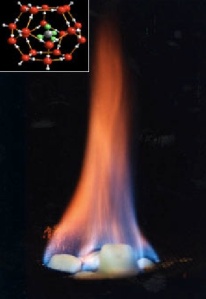
Flame over methane hydrate and its clathrate crystal structure.
(Source: United States Geological Survey)
If you’ve been involved in the energy sector for as long as me, you’ve undoubtedly heard endless speculation and debate over the direction of our energy future. Specifically, what energy source is capable of succeeding coal, oil, and natural gas? Most often, this discussion is framed as,”How will we displace our use of carbon-based supplies?”
But, have you ever stopped to think about what the energy future would look like if, rather than barreling off the downslope of Hubert’s Peak, we discovered how to commercially tap a vast new source of the cleanest of hydrocarbons–methane? And, what if that new supply of natural gas had nothing to do with hydrofracturing? Then what?
That’s the question more people may soon be asking if ongoing research results in more reports, such as the one this week from Japan. Methane hydrate, which can be found just under the earth’s surface throughout much of the world, is that exciting new energy source.
Methane hydrate is a naturally occurring chemical compound in which molecules of methane (natural gas) are embedded within ice, forming “clathrate.” A precise combination of temperature and pressure must exist for the unstable hydrate to form. As a result, it is extremely difficult to capture the methane before the hydrate dissociates into water and natural gas.
Although the compound is sensitive to temperature and pressure conditions, methane hydrate has been found throughout the world both on land, particularly in the arctic, and beneath the sea. Areas where the continental shelves transition to the deep ocean appear to provide favorable conditions for methane hydrate formation.
Scientists and engineers worldwide are diligently working to provide us with the keys to unlocking this new source of natural gas. In fact, over a decade ago, the U.S. government passed into law the “Methane Hydrate Research and Development Act of 2000.”
The Department of Energy (“DOE”) leads the R&D programs and coordinates an alphabet soup of federal agencies and departments including, the BLM, BOEMRE, NOAA, NRL, NSF, and USGS researching methane hydrate. DOE is tasked with expanding our understanding of methane hydrate so that ultimately it may be developed as a viable energy resource.
Other countries including Canada, China, Japan, Norway, and South Korea as well as academic institutions and private companies, including such energy giants as BP, ConocoPhillips, ExxonMobil, have hydrate research projects underway. Following Fukushima, Japan with relatively few domestic energy resources, is especially keen to discover how to harvest methane hydrate.
As with most any fundamental research, from an outsider’s perspective, progress appears to move at glacial speed. However, such broad-based interest and allocation of resources doesn’t materialize unless there is significant potential for a major breakthrough in technology. When the understanding of methane hydrate progresses to the commercial development stage, it will usher in an energy revolution greater than the current “fracking revolution.”
Consider the potential impact of methane hydrate as an energy source. The U.S. MMS (now part of the BOEMRE) estimated that there is somewhere between 11,000 and 34,000 trillion cubic feet (“Tcf”) of methane hydrate under the continental shelf in the northern Gulf of Mexico. About 6,700 Tcf of that may be commercially viable to extract. (from DOE/NETL publication, “Energy Resource Potential of Methane Hydrate”) According to the Potential Gas Committee, the total U.S. natural gas resource base, not counting methane hydrate, is slightly over 2,000 Tcf…enough to meet our needs for the remainder of this century.
Assuming a typical recovery rate of about thirty percent of that 6,700 Tcf quantity, the U.S. could double its total natural gas resource base with methane hydrate from the Gulf of Mexico alone. In other words, the U.S. would have enough natural gas to satisfy demand at existing levels during this century and most of the next.
Clearly, we are a long way from being able to commercially produce substantial quantities of natural gas from methane hydrate. There is much we don’t know about the compound and technical challenges to safely and responsibly produce it are considerable. But, as the news from Japan indicates, progress continues to be made.
To some, such as 350.org, the prospect of massive new supplies of natural gas is the death knell for reducing man-made global CO2 emissions. Nothing is more frightening. But, I tend to believe just the opposite. It may be the world’s best prospect for reducing global CO2 levels.
Scientists tell us that reducing CO2 emissions in the developed countries isn’t the key to lowering GHG levels worldwide. The focus must be on developing countries. Absent economically viable alternatives to coal and petroleum fuels, these countries will follow the historic path of the developed nations by using the cheapest, most readily available energy sources. There must be suitable substitutes for coal and petroleum.
Wind and solar are intermittent and exorbitantly expensive in the context of developing markets, therefore cannot be deemed viable substitutes. Nuclear is a good base load energy source, but initial capital expenses for its development price it out of the reach of most developing nations.
Like it or not, natural gas is the only abundant, reasonably priced alternative that can compete with cheap coal. By emitting less than half of the CO2 of conventional coal, developing regions using more natural gas results in a viable way forward for those concerned about climate change.
We are not yet capable of tapping the potential of methane hydrate, but just as the decades long scientific and technological research that brought about hydraulic fracturing and horizontal drilling, the basic research on this exciting new frontier presses ahead. Glimpses of the energy future appear to reveal even more natural gas.
